Drumometer
Education and Exercises
NOTE:
The listed exercises are merely a few examples of
many various Drumometer exercises. Visit this site
often for new exercise updates or feel free to email
us your own original exercises!
DRUMOMETER
As a Teaching Tool
A
surprise benefit of the machine is the almost feverish
addiction to practice that it causes as students
can't seem to get enough!
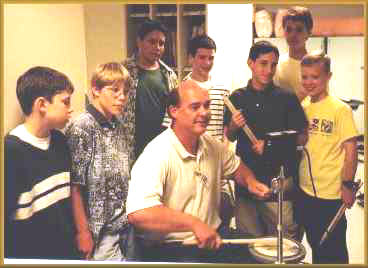
Photo
courtesy of Ron Kestner
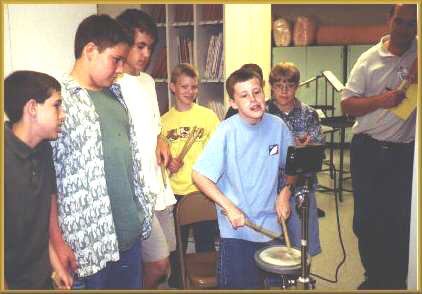
Drum
Instructor, Allen Gentry, uses the Drumometer to
coach drum students at Robinson Middle School in
Kingsport, TN.
Photo
courtesy of Ron Kestner
Knowledge
is nothing more than the breaking down of barriers.
No matter what endeavors one may undertake, it is the
journey, not the destination, from which we learn the
most. When great explorers embark on a journey, they
know that there are certain instruments that they will
need to make their desired destination. Music, in and
of itself, is a wonderful journey, and it too requires
the right instruments or tools to reach the desired
goals. The Drumometer is one of those instruments. The
Drumometer along with The Progress Report gives any
student one of the most important tools he/she needs
to reach his/her own musical destination. Naturally,
a drummer's ability and musicianship are not gauged
by speed alone; however, muscle and stick control can
be measured by the Drumometer and progress can be quantified
and guided into productive practice techniques.
The
speed and technique gained are just means to an end
- the end being the confidence, joy and freedom that
a student receives from breaking down and going past
what seemed to be unattainable goals. This is what education
and music are all about.
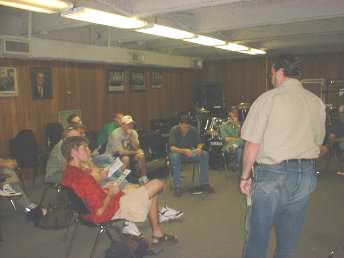 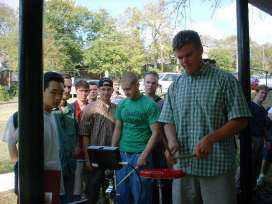
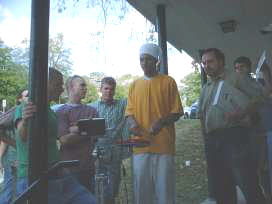 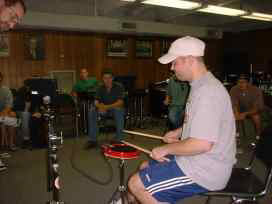
Percussion
students at Belmont University using the Drumometer

The Progress Report
and Procedure
The
process starts with The Progress Report as seen below.
The Progress Report can be designed to track the progress
of any objective, including all of the rudiments. The
basic Progress Report enclosed was designed to track
the student's progress of the Single Stroke Roll, Double
Stroke Roll, Single Paradiddles, the Right and Left
Hand individually, and the INNER-CLOCK TEST™.
The basic Report is designed using three increments,
10 seconds, 30 seconds and 60 seconds.
Once
the student has learned his/her singles, doubles, paradiddles
and right and left-hand taps, he/she is ready for the
Drumometer. The first session with the Drumometer becomes
the starting point for each student and is dated and
recorded as such. Each student starts at 10 seconds
and is asked to play a single stroke roll. At the end
of 10 seconds the Drumometer stops and the amount of
strokes are captured and recorded. Next, the student
runs his/her doubles for 10 seconds and the paradiddles
for ten seconds. The student is then asked to run single
taps with the right hand only and then with the left
hand only. The wonderful aspect to the right and left-hand
testing is the fact that it lets teacher and student
isolate the hands to determine which is the weaker of
the two. Once each rudiment has been tested at 10 seconds,
the Drumometer is set at 30 seconds and the procedure
is repeated and recorded. Then, it is on to the 60-second
level. The information received from these increments
is very interesting, due to the simple fact that endurance
enters into the equation. As the student moves from
10 seconds to 30 seconds to 60 seconds, he/she quickly
realizes that it is not about speed alone, but all of
the other factors now come into play. At the end of
the first testing session, the instructor talks through
the report, explaining what happened to produce each
score along the way. Example: Two of the early things
the instructor points out and the student quickly connects
with are the simple facts that distance (stick height)
produces more volume but less speed. Additionally, the
student learns that the larger muscles may be more powerful,
but not necessarily faster. The instructor then has
paved the way toward awareness of stick control and
finesse, and when the student is ready, more use of
the fingers. It also becomes apparent that any individual's
single strokes are only going to be as fast as his or
her weaker hand single taps (given a few points for
the coordination factor). So, by tracking the progress
of the weaker hand, we see the development in the overall
rudiment. After this initial session and consultation
on the results, the instructor can analyze each tested
rudiment with the student and design a daily practice
schedule for each rudiment.
Both the student and the instructor are now armed with
valuable documentation of exactly where the student
is at this point in time. With this information from
the instructor and the Progress Report it is, of course,
up to the student to go home and practice. If the student
follows the instructor's advice and adheres to the designated
practice schedule, the results will be evident, due
to the accuracy of the Drumometer. The student knows
that the machine is accurate and that if he/she truly
practices in the proper manner, the results will speak
for themselves. If testing is done and recorded on a
frequent basis, each student will actually see his/her
progress - no longer guessing as to whether he/she is
improving. What a reward! The Drumometer and Progress
Report are designed to be a part of every student's
progress for life - from beginner to professional.
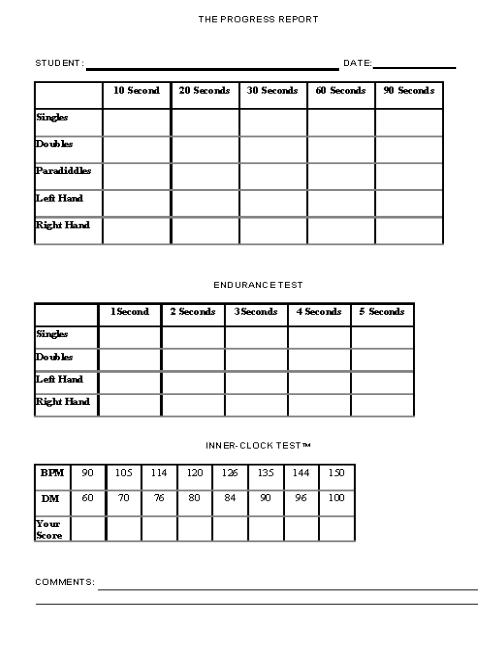
CLICK
HERE TO DOWNLOAD YOUR COPY OF THE PROGRESS REPORT
You'll
need Adobe Acrobat Reader to print this document.
download free Acrobat Reader

Feel
free to download and copy the Progress Report pdf!

INNER-CLOCK TEST™
This
exercise checks your concept and grasp of internal time.
1) Basic Level: Start off by setting the metronome
at 120 bpm.
2) Next, set the Drumometer at 10 SECONDS and play
sixteenth notes. If they are dead-on, the Drumometer
COUNT will be at 80 DM (DM = Drumometer Marking).
3) Take it up a level by setting the metronome at
133 bpm and the Drumometer at 30 SECONDS and play
sextuplets for 30 SECONDS. The Drumometer will be
at 399 DM if you are dead-on.
4) Advanced Level: Start by getting inside yourself
and trying to find 120 bpm without the metronome!
Again play sixteenth notes for 10 SECONDS. If you
Inner-Clock is perfect the Drumometer will be at 80
DM.
5) Now, repeat exercise C without the metronome. How
is your Inner- Clock? This advances to wherever you
want to go say, 7's, 9's or 11's at 97 etc.
Example:
Try playing the following pattern at 120 bpm without
the metronome for 10 seconds. If your Inner-Clock is
accurate, the Drumometer will be at 80 DM at the end
of the 10 seconds.

Once
you succeed with 120 bpm, test your Inner-Clock with
other tempos and patterns. The below chart shows the
Drumometer Markings for 16th notes played for 10 seconds
at several different tempos.


STICK
CONTROL EXERCISES
This
procedure can be used to increase your proficiency with
any rudiment, sticking, or pattern, and can be used
in conjunction with any of the exercises in George Lawrence
Stone's Stick Control. For this example, the Single
Stroke Exercise is illustrated.
1) With the timer set at 10 SECONDS, play your singles
at a very slow pace. Be sure to take good full strokes
and keep the pace even. Repeat this process three
or four times at the same pace. You should hit the
same Drumometer Marking (or close to it) each run
if you are keeping a consistent and relaxed pace.
2) Pick a slightly faster pace and follow the same
procedure as in 1.
3) Repeat the procedure in 2 until you have gradually
reached your top speed. Things to remember about your
top speed are this: NEVER strain your muscles or play
all tensed up. Your strokes should be consistent and
not flurries of playing of notes. You should have
good posture and your top speed may vary from session
to session, but if you follow this routine, it will
have a definite upward slope over time.
4) Repeat 1 - 2 with the timer now set at 20 SECONDS,
then 30 SECONDS, and so on, until you reach your peak
speed at 90 SECONDS. Gradually work your way up the
time ladder so as to increase your endurance in a
healthy way.
5) Remember if you are doing this correctly, your
top speed will be the same for every 10 seconds of
time. For example, if you are running singles at a
top speed of 100 DM for 10 seconds, then you should
run about 200 DM for 20 seconds, 300 DM for 30 seconds,
and so on as you go up the time ladder.
6) Even strokes should be your goal. You can watch
the counter as you play to see how evenly you are
striking the pad. If the counter stutters, you should
make an immediate correction to how you are striking
the pad so as to achieve the desired flow from the
counter. You will notice your hands starting to look
and sound more alike as you do this routine over time.
(Note: Contrary look = contrary sound.) You will also
notice you can play longer and more consistently with
less effort which is the goal of proficiency.

THE ENDURANCE TEST
by Johnny Rabb

This
procedure can be used to increase your endurance and
will quickly show deficiency due to a lack of endurance.
1) Set the timer to 01 SECONDS
2) Run at your top speed
3) Now set the Drumometer to 02 SECONDS
4) Run again at your top speed. The COUNT should be
double what you recorded for 01 SECONDS. For instance,
if you had a COUNT of 20 for 01 SECONDS and a COUNT
of 37 for 02 SECONDS, you have an endurance deficiency
of 3 strokes at 2 seconds.
5) Once you determine where your endurance deficiency
is, i.e 2 seconds, you should continue to repeat the
test until there is no endurance deficiency at this
level. Once this is accomplished increase the timer
by 1 second and repeat the test.

Improving
Technique and Speed with The Drumometer by Art Verdi
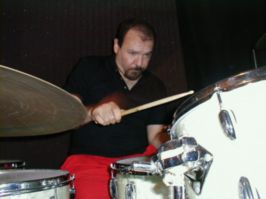
There is a natural evolution that exists in every
industry and the drumming industry is no exception.
Over time, we see new products, new techniques,
and even new controversies -- which render new questions.
A lot of questions and controversies arose from
the creation of the Drumometer. I will explain its
purpose, different ways to work with it, the benefits
of its use, and how to increase your speed with
the Drumometer.
Relaxation
and Repetition
The
Drumometer is a wonderful practice motivator if
used right. WFD Champ Jotan Afanador told me that
his first 1-minute run was around 950. And, in just
a few years, he went to over 1200 strokes in 60
seconds I don't think Jotan would be able to increase
this kind of speed without practicing with the Drumometer.
Jotan's method was to start a single stroke roll
very relaxed for the first few 1-minute runs, and
purposely not pay attention to what the scores of
these runs would read.
First, try doing 20 to 30 one-minute single strokes
in a row without stopping. Most drummers have the
old Drumometer that only allows you 60 or 90 seconds
at a time. So, if you have this model, simply keep
hitting the reset button on the Drumometer for 1
half-hour. And, if you have the new Drumometer,
all you have to do is hit the reset button once,
because you can set it for 900 seconds or 15 minutes.
Don't worry what the score says and stay relaxed.
If you care too much about what the score reads,
you will start to tense up, and this will defeat
the purpose and lead to hand injury. Within about
2 weeks time, your score should really jump -- hands
or feet.
Developing
Endurance
To
really develop a great technique, a drummer must work
on endurance exercises. Likewise, in order to play
very fast single strokes and hold it for 60 seconds,
a drummer has to develop endurance to maintain these
speeds. The Stick Control Book by George L Stone or
the Master Studies book by Joe Morello is great to
practice as long as the drummer keeps practicing without
stopping. If a drummer works out with the Stick Control
Book, or practices these Drumometer exercises that
I'm explaining, and sits there for at least 1 half
hour without stopping, he will develop endurance and
speed. A lot of drummers do these exercises for 5
minutes then get up for coffee then go back! This
is unacceptable if you want to develop endurance.
Tiger Bill Meligari told me he would find a good 2
hour movie put it on and play single strokes throughout
the 2 hour movie without stopping -- Now that's developing
endurance.
Muscle
Breakdown and Its Effects
If you practice these exercises and find your score
is decreasing, do not panic. Sometimes when you are
reaching a new peak of speed, your muscles can start
to break down and you will lose speed for a few days
-- then out of nowhere, you see the improvement. It's
a great feeling and worth all the effort when you can
play faster than you ever were able to. It takes a lot
of time to reach each peak of speed improvement, but
what a treat when you do! Sometimes it's like standing
on the top of a high mountain and screaming like Tarzan!
Ha Ha!
Controlled Relaxed Speed for Practical Applications
We are not as concerned with the high numbers on the
Drumometer as much as we are concerned that the minute
run is played technically correct in the WFD competitions.
If the drummer alters his way of playing just to break
a record, that doesn't impress WFD. The drummer must
play the run exactly the way he plays the drums. What
good is playing fast with the Drumometer if you can't
apply it to the instrument? Everything we practice must
be for the benefit of the instrument. If a trumpet player
develops fast chops with just the mouth piece and doesn't
practice playing the trumpet, what good is it!? Ha Ha!
Practicing with a relaxed run and increasing the speed
naturally is much better than attacking the pad tense
just to see 1000 strokes. If a drummer shows me a relaxed
950, I would be more impressed than he if shows me a
very tense 1020.
The
Members & Perspectives of the WFD
The WFD competitions are a motivator for drummers to
practice more and develop better technique. These competitions
are like a Major League Home Run Derby before the all-star
game. The players (FOR FUN) see how many home runs they
can hit, but when the game starts, they play for the
team. Similarly, the drummers see how fast they can
play, but the WFD expects those drummers to play for
the band when playing a gig. If a drummer doesn't understand
this concept, we feel it's that this could be due to
the mis-guidance of teachers, not the WFD.
The WFD drummers were very experienced players long
before there was a WFD. And these guys are with the
WFD because they believe in what the WFD is trying to
do. Boo McAfee (then called Boo Boo McAfee) was known
for years in Nashville as a great soul-grooving drummer.
He surely knows what a drummer has to do first to be
a great drummer.
Using the Drumometer in Conjunction with the
Metronome
I personally feel that keeping a daily log on your progress
can be a great motivator to keep on practicing hard.
Years ago when I was developing my technique, all I
had was a metronome. With a metronome you had to guess
your improvement; now with the Drumometer, you can see
improvement by even one stroke which would have been
impossible to see using the metronome only. BUT, I believe
in practicing with both the metronome and Drumometer.
(The new Drumometer II actually has a built in metronome
that goes up to 300 bpm and includes a volume control.)
I think a drummer can pace himself to find a proper
speed he can handle without straining through the minute
run. A metronome with a tap button will enable the drummer
to find his 1-minute relaxed speed much easier and can
eliminate any injury from straining.
Common Flaws to Avoid
I noticed in speed competitions that the drummer's stick
height would hinder their scores. Remember -- the lower
the stick is to the pad, the faster one can play. Some
drummers are competing with the stick far too high at
10 to 12 inches off the pad. Another problem I noticed
is drummers not concentrating on hitting in the middle
of the pad. When the sticks start hitting the rim of
the pad, a drummer loses tons of strokes. Also, when
a drummer buzzes the pad instead of making one stroke,
the run is disqualified because the Drumometer registers
every stroke of the buzz, which is unfair to other competitors
in the speed competition.
Improving your Sense of Timing
You can also improve your timing with the Drumometer.
Set the metronome to 120 BPM and play quarter notes
for 60 seconds. The Drumometer should read 120. Now
try this again at the same speed without the metronome
and see how close you can come to 120 without the metronome
as a guide. The WFD calls this the internal clock practice.
This can really develop your sense of timing. I'm sure
there are many great ideas you can apply to this unit
that have not been thought of yet, but will be discovered
in time. And it will result in drummers with a much
greater technique and sense of time.
Recommended Sources for Improvement
Johnny Rabb has a great DVD on how to practice with
the Drumometer called 30 Days to Better Hands,
and my DVD is called Practicing Properly.
I use the Drumometer a lot in this DVD. You can get
your copy of these and other DVDs by clicking here.
Natural Evolution of Human Potential
To give you a concept of the progression of speed in
time by using the Drumometer, notice these results:
Johnny Rabb was the first to break 1000; I was the first
to break 1100; and now Mike Mangini is the first to
break 1200.
In Conclusion
Always have a goal when practicing with the Drumometer.
If you can do 850, keep trying for 900. If you can do
950, keep trying to break 1000. Mike Mangini can do
close to 1250, and I'm sure he has 1300 in mind as this
is being written. In fact, the two guys that can perhaps
reach it right now (or soon) are Mike Mangini and Jotan
Afanador. Go for it guys and keep practicing with all
the determination you have, and you will see the results
you want to see.
God
Bless,
Art Verdi
Special thanks to Dan Britt for his assistance with
this article.
Art Verdi is a WFD Champ and the first person to
break 1,100 strokes in 60 seconds. Art has conducted
numerous master classes on the topic of hand technique
and has performed with several greats to include Jack
Wilkins (Buddy Rich Band), Shirley Scott (John Coltrane,
Bill Cosby), Sal Salvador (Stan Kenton), Phil Woods
(Benny Goodman), and Stanley Turrentine (Max Roach,
Ray Charles).
To view video clips of Art and his DVD Practicing Properly,
please go to www.artverdi.com

|
